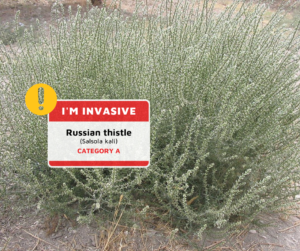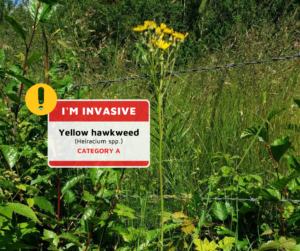TOP INVADERS IN THE PEACE REGION: CATEGORY A - HIGH PRIORITY FOR ERADICATION AND CONTAINMENT
Recognized by its burrs that stick to clothes and animals, this plant grows tall and has deep brownish-green roots that are nearly black on the outside.
Burdock has purple flowers on tips of prickly bracts that bloom between June and October.
If you see this plant:
- Submit a report to the Province of BC
- Do not compost
- Pull, clear bag and toss small infestations for free at Bessborough, Chetwynd and North Peace landfills
Comfrey has a leafy stem covered in bristly hairs at the top with large rough leaves at the bottom and is toxic to livestock.
This plant is recognized by clusters of drooping flowers that are either yellow or purple, growing on short curved stalks. The bell-shaped flowers bloom throughout the summer.
If you see this plant:
- Submit a report to the Province of BC
- Do not compost
- Pull, clear bag and toss small infestations for free at Bessborough, Chetwynd and North Peace landfills
Tansy is a flowering herbaceous plant with finely divided compound leaves and yellow, button-like flowers that are flat on the top and bloom in mid to late summer.
The stem is usually smooth and grows 50 to 150 cm tall, and the leaves are divided and have a fern-like appearance. The leaves and flowers are toxic if consumed in large quantities.
Tansy has a camphor scent with a hint of rosemary.
If you see this plant:
- Submit a report to the Province of BC
- Do not compost
- Pull, clear bag and toss small infestations for free at Bessborough, Chetwynd and North Peace landfills
Green foxtail is an annual that reproduces by seed and grows in clumps. The leaf sheath is smooth and lined with short upward-pointing hairs that are most noticeable by its "collar".
Leaf blades are flat and grow 25 cm long and 6 to 18 mm wide, with sharp tips. The head of a mature foxtail is a fuzzy tapered cylinder with upward barbs.
If you see this plant:
- Submit a report to the Province of BC
- Do not compost
- Pull, clear bag and toss small infestations for free at Bessborough, Chetwynd and North Peace landfills
Orange hawkweed has erect and usually leafless stems covered in bristly hairs. They grow 15 to 90 cm tall and contain milky sap.
The flowers are orange-red and have square edged/notched petals. You can spot this plant by the long bristly hairs and black glands at the base of the flower.
The only hawkweed to have orange flowers; they might seem pretty, but do not use this plant as a garden ornamental.
If you see this plant:
- Submit a report to the Province of BC
- Do not compost
- Pull, clear bag and toss small infestations for free at Bessborough, Chetwynd and North Peace landfills
A bushy summer annual with many slender stems that become woody as they mature. Russian thistle is more commonly known as 'tumbleweed'.
Once the plant dries, the base stem breaks off in the fall and early winter and disperses its invasive seeds as it tumbles in the wind.
Be on the lookout for this invasive as it matures in July through October, and spot it by the spine-tipped leaves at its base.
If you see this plant:
- Submit a report to the Province of BC
- Do not compost
- Pull, clear bag and toss small infestations for free at Bessborough, Chetwynd and North Peace landfills
Spotted knapweed is a biennial or a short-lived perennial, with black spots on the base leaf leading into the flower. The flowering stems are furry and grow 20 cm to 1.3 m tall.
Easily spot this plant by its purple to pink (rarely white) head of flowers that bloom from June to October. Check your clothing for brown oval seeds 1 to 3 mm long with a pale line.
f you see this plant:
- Submit a report to the Province of BC
- Do not compost
- Pull, clear bag and toss small infestations for free at Bessborough, Chetwynd and North Peace landfills
Yellow hawkweed is a perennial that can grow up to 90 cm tall and excretes a milky fluid when injured.
Flower heads are in compact, flat-topped clusters with fused petals that form a strap-like shape. Leaves grow near the ground and are covered in hair. The stems have dense hairs at the bottom and finer hairs at the top.
If you see this plant:
- Submit a report to the Province of BC
- Do not compost
- Pull, clear bag and toss small infestations for free at Bessborough, Chetwynd and North Peace landfills
Invasive plants are pests
Noxious weeds alter habitats and disrupt essential ecosystem functions.
Once established, invasive plants are costly to manage and almost impossible to eradicate.
- Endanger public health and safety by increasing hay fever allergies and have toxic properties that can harm humans, pets, livestock and wildlife;
- Out-compete native vegetation and destroy natural habitats;
- Reduce agriculture forage yields and hay quality;
- Increase wildfire hazards and interfere with regeneration of forests;
- Decrease land values and impact recreation areas;
- Accelerate soil erosion and cause stream sedimentation with negative impacts to water quality.
Ways you can help
Get PlantWise and learn to recognize what plants are invasive in the Peace region and know what you grow.
Type the name of an invasive plant into the BC Invasive Species Council module below, or read through the PRRD Invasive Plant profile. Plant ID booklets are available at the PRRD offices in Dawson Creek and Fort St. John, and can also be mailed by request.
PRRD Invasive Plant Profile
Invasive plants can be reported directly to the Inter-Ministry Invasive Species Working Group (IMISWG) - a Provincial body, or to the PRRD.
If a report is submitted to the PRRD for a residential property within the jurisdiction of the Regional District, staff will forward the report to the appropriate agency and deliver educational materials that outline how to identify and manage specific species on residential properties.
The PRRD can only spray on properties owned and operated by the Regional District.
If a report is submitted through the Report Invasives app or via the Provincial online form, the IMISWG will review and coordinate with an invasive species specialist for follow-up activities.
Download the IMISWG free reporting app:
Report using the Provincial online form:
Report to the PRRD:
- Submit a PRRD Weed Form OR;
- Call 800-670-7773 OR;
- Email the environmental services team
Invasive plant bins are available at the below participating PRRD solid waste facilities from May 15 to mid-October. Five clear bags are also available for pick up at these locations.
If you find invasive plants on your property remove the plants, place them in clear plastic bags and take them to one of the below stations for free.
*Black or opaque garbage bags are not accepted.
Participating Locations +
- Bessborough Landfill
- Chetwynd Landfill
- North Peace Landfill
- Buick Creek Transfer Station
- Cecil Lake Transfer Station
- Dawson Creek Transfer Station
- Goodlow Transfer Station
- Kelly Lake Transfer Station
- Moberly Lake Transfer Station
- Pink Mountain Transfer Station
- Prespatou Transfer Station
- Rolla Transfer Station
- Rose Prairie Transfer Station
- Tomslake Transfer Station
- Wonowon Transfer Station
- Upper Halfway Transfer Station
- Avoid purchasing, growing or trading unknown invasive plants and replace with non-invasive alternatives;
- Deadhead (clip off) flowers, seedpods and berries of known invasive plants to prevent reproduction;
- Use wildflower seed mixes with caution; read the label and check location compatibility;
- Avoid picking plants along roadsides, gravel pits or other disturbed areas;
- Clean recreation vehicles before and after entering in a new area;
- Properly dispose of yard, garden and hanging basket waste into a compost pile or facility;
- Do not compost invasive plants with seeds; dispose at a local landfill;
- Prior to purchasing seed, ask for a seed analysis report to verify additional seeds that may be present.
Did you know?
- Invasive plants are spread by birds, wildlife, pets and people;
- Many wildflowers contain invasive plant seeds;
- Picking plants along the road or other disturbed areas encourages spread;
- Invasive plants can be spread by your vehicle entering into a new area;
- Composting invasive plants does not prevent spread.












